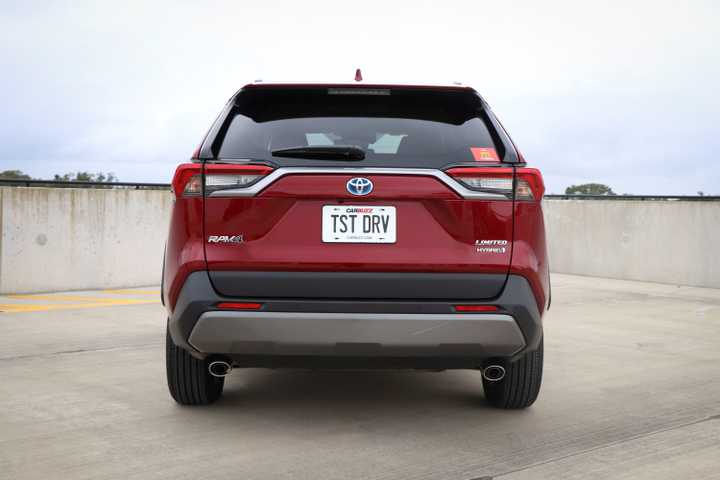Toyota, as a brand, is known for creating vehicles with excellent resale value. This is thanks to its reliability, which means that these cars last extremely long, even as they pass through the hands of multiple owners. Compare that to other brands, wherein their resale value is largely dictated by their remaining useful life.


- Base Trim Engine
-
2.5L Inline-4 Hybrid
- Base Trim Transmission
-
Continuously Variable Automatic (CVT)
- Base Trim Drivetrain
-
All-Wheel Drive
- Base Trim Horsepower
-
219 hp
- Base Trim Torque
-
163 lb-ft @ 3600 rpm
- Fuel Economy
-
41/38 MPG
- Make
-
Toyota
- Model
-
RAV4 Hybrid
- Segment
-
Compact SUV
Sometimes, high-volume vehicles also have lower resale values due to their sheer commonality, which results in higher supply. The thing is, though, that’s not the case with the Toyota RAV4 Hybrid. Even if it’s the outright best-selling vehicle in 2024, it still has one of the highest resale values in the industry, especially when looking at a three-year-old model. However, due to its reliability, it’s probably worth considering one instead of going the brand-new route.
In order to give you the most up-to-date and accurate information possible, the data used to compile this article was sourced from various manufacturer websites and other authoritative sources, including Toyota, iSeeCars, and Honda.
Best-In-Class Resale Value
Regardless of which RAV4 Hybrid age you’re looking at, iSeeCars says that this electrified Toyota crossover SUV has the best resale value among hybrid compact crossover SUVs. How much does a three-year-old model lose? Not a lot, actually. In fact, if you’re the type of buyer who frequently wants to change cars (probably every three years), you will lose the least amount of money in the RAV4 Hybrid.
As A Buyer, You’ll Pay Around $27,744
Now, if you’re in the market for a three-year-old RAV4 Hybrid, the average used price for one is $27,744. That’s a value loss of just 14.1 percent over three years – far lower than the 23.2 percent of the hybrid compact crossover SUV segment, let alone the industry average of 31.7 percent. As an owner, that’s good news, but as a buyer, that means that a three-year-old RAV4 isn’t cheap. Here’s how the RAV4 Hybrid stacks up versus the entire industry average, along with its resale value as it ages.
|
3-Year Depreciation |
5-Year Depreciation |
7-Year Depreciation |
10-Year Depreciation |
|
|---|---|---|---|---|
|
Toyota RAV4 Hybrid |
14.1% |
30.1% |
46% |
62.8% |
|
Hybrid Compact SUV Average |
23.2% |
36.3% |
47.5% |
69.4% |
|
SUV Average |
33.1% |
49% |
60% |
70.8% |
|
Industry Average |
31.7% |
45.5% |
56.5% |
67.4% |
|
Vehicle Age |
% Depreciation |
$ Depreciation |
% Residual Value |
$ Residual Value |
|---|---|---|---|---|
|
3 Years |
14.1% |
$4,556 |
85.9% |
$27,744 |
|
5 Years |
30.1% |
$9,714 |
69.9% |
$22,586 |
|
7 Years |
46% |
$14,844 |
54% |
$17,456 |
|
10 Years |
62.8% |
$20,270 |
37.2% |
$12,030 |
You’ll Probably Consider A Three-Year-Old RAV4 Hybrid
Yes, a three-year-old RAV4 Hybrid isn’t cheap as far as used car prices go. However, it certainly is tempting if you’re originally considering a brand-new model. If you buy a new RAV4 Hybrid in 2025, you’ll have to pony up $32,850 for a base LE. That’s not even a fancy pants variant, as you’ll only be getting stuff like 17-inch wheels, cloth seats, a urethane steering wheel, but at least it still has all the modern amenities you need, but not want. These include a 7-inch digital gauge cluster, an eight-inch Toyota Audio Multimedia infotainment with wireless Apple CarPlay and Android Auto, and rear AC vents.
Now, what if I told you that for about the same money as a base LE, you could get a higher-grade XLE or even an XLE Premium or Woodland Edition, albeit a three-year-old one, and depending on their condition? Sure, it may not be brand spanking new, but hey, these variants are far better equipped with stuff like leather upholstery, a powered tailgate, gray 18-inch or bronze TRD 18-inch wheels, a power-adjustable driver’s seat, wireless charging, and a sunroof. I know which I’d rather pick.
What A RAV4 Hybrid Is Like To Drive
If you’ve reached this segment of the article, you’re probably seriously considering this two-row hybrid SUV. Well, you’ve come to the right place, as I and the rest of the TopSpeed team have comprehensively tested the RAV4 Hybrid.
Effortless Efficiency
When I reviewed the RAV4 Hybrid back in 2022, achieving high fuel efficiency wasn’t even something you’d need to deliberately do. Just driving it how you would in other vehicles, even if you’re leadfooted, will yield high fuel economy figures. In my case, after a week’s worth of driving, I achieved 18.2 km/l, or 42.8 MPG, most of which were on clear high-speed roads (I don’t live in the city). For reference, this is a Philippine-spec unit, which doesn’t come with electronic all-wheel drive (AWD). Anyway, even with AWD, the 39 MPG claimed EPA-estimated combined figure is going to be easily achievable for you.
Credit is due to the fourth-generation Toyota Hybrid System (THS IV). Though it’s already been succeeded by the current THS V in the new RAV4 and the new Camry, the 2.5-liter hybrid system of THS IV is extremely efficient. This is due to its planetary gear-type e-CVT (it’s not a CVT in the most traditional belt-and-pulley sense), which provides near-infinite ratios, but at the expense of a linear driving feel. The engine drone will be your most common audible sound with this hybrid system.
Reasonably Well-Judged Drive
Treat the RAV4 Hybrid and its 219-horsepower output sensibly, though, and that’s enough system output for you to have a relaxed driving experience. That engine drone won’t be something you’ll experience a lot, since the hybrid system is responsive and delivers power smoothly. Equally smooth is the driving experience, whose suspension tuning is biased towards comfort.
|
Toyota RAV4 Hybrid |
|
|
Engine |
2.5-liter four-cylinder hybrid |
|
Horsepower |
219 hp |
|
Torque |
N/A |
|
Drivetrain |
AWD |
|
Fuel Economy (Combined) |
39 MPG (35 MPG for Woodland Edition) |
|
Max Towing |
1,750 lbs |
|
3-Year-Old Value |
$27,744 |
It isn’t as sporty as the CR-V, or let alone the CX-5, but with steering that’s reasonably responsive, along with good-enough body control, the RAV4 Hybrid simply fades into the background. Refinement is also pretty good, with minimal road and wind noise entering through the cabin. Once again, if you don’t mash the throttle too hard, the result is a serene driving experience, since the strong electric motors help in keeping engine noise at bay.
The Honda Alternative – The CR-V Hybrid
Toyota may have all the attention when it comes to hybrids, but Honda has also been playing the hybrid game just as long as Toyota. If you’re considering a three-year-old RAV4 Hybrid, the CR-V Hybrid has the fifth-highest resale value among compact hybrid SUVs, whilst being second when compared apples-to-apples with the similarly-sized RAV4. A three-year-old CR-V Hybrid has an average resale of $26,596, which is a little over a thousand less than its Toyota equivalent.
A Higher Degree Of Electric Driving
A three-year-old CR-V Hybrid means opting for a previous-generation model, which our friends from the CarBuzz team has reviewed. To be fair, even that model stacks up well with the RAV4 Hybrid, since it is mostly due to Honda having a shorter generational cycle than Toyota. Even in this generation of the CR-V, Honda has already been using an older version of its current e:HEV system.
Versus Toyota’s planetary gear e-CVT, Honda’s lock-up clutch-based e-CVT (it simply connects and disconnects the engine) enables a higher percentage of pure electric driving. Effectively, think of it as a single-speed automatic that simply links to the engine when needed only, but this results in a smoother drive. This layout enables the engine to charge the battery without connecting to the wheels, which is not possible with Toyota’s planetary gear e-CVT.
Serenity At Its Core
As a result of this higher degree of electric driving, the CR-V Hybrid can sometimes be the more serene hybrid crossover versus the RAV4. It also has a slightly sportier drive, with incrementally sharper steering and well-judged body control. This is an era where the CR-V still focuses on being heavily biased towards comfort, so if a sportier CR-V is what you’re after, then you’ll have to look for a used current-generation model.
|
Honda CR-V Hybrid |
|
|
Engine |
2.0-liter four-cylinder hybrid |
|
Horsepower |
212 hp |
|
Torque |
232 lb-ft |
|
Drivetrain |
FWD, AWD |
|
Fuel Economy (Combined) |
38 MPG |
|
Max Towing |
1,000 lbs |
|
3-Year-Old Value |
$26,596 |
Of course, when you mash the throttle, the engine drone will be your companion. That’s been solved with the current CR-V Hybrid’s Linear Shift Control, which introduces simulated gear shifts to avoid just that. Furthermore, helping the efficiency and engine flexibility is the addition of a second lock-up clutch in the current CR-V Hybrid. This time around, you can think of the current CR-V Hybrid as having a two-speed automatic.
Source: iSeeCars












